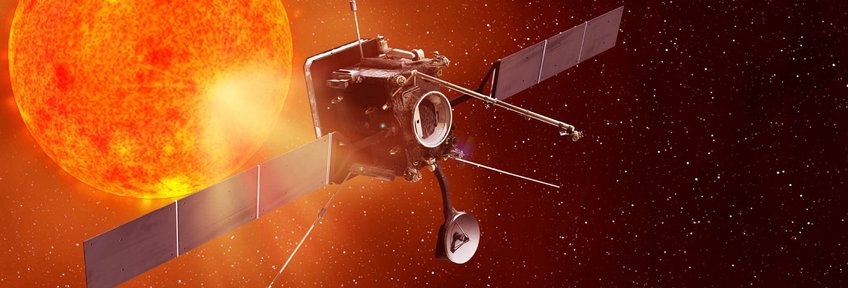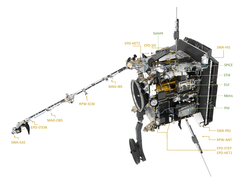
Solar Orbiter: High-Resolution Mission to the Sun and Inner Heliosphere addressing the Sun-Heliosphere and Sun-Earth connections
Solar Orbiter is a mission dedicated to solar and heliospheric physics. It is a joint mission of ESA and NASA. Solar Orbiter was launched on Feb. 10th, 2020 from Cape Canaveral on an ATLAS V. After multiple gravitational assist manoeuvres at Earth and Venus, it has started its full science operations in December 2021.
The scientific rationale of the Solar Orbiter is to provide, at high spatial and temporal resolution, multi-wavelength observations of the solar atmosphere and comprehensive in-situ measurements of the unexplored inner heliosphere. By approaching the Sun as close as 0.28 AU (Astronomical Unit, the mean Earth to Sun distance), Solar Orbiter views and diagnoses the solar atmosphere globally and with high spatial resolution and combines this with measurements of particles and fields made in-situ. Over its extended mission periods the Solar Orbiter will move out of the ecliptic plane to deliver images and related data that will cover the polar regions of the Sun. By its payload complement, Solar Orbiter investigates the key topic of heliophysics: How does the Sun create and control the heliosphere?
The four main scientific questions addressed by the Solar Orbiter mission are:
- How and where do the solar wind plasma and magnetic field originate in the corona?
- How do solar transients drive heliospheric variability?
- How do solar eruptions produce energetic particle radiation that fills the heliosphere?
- How does the solar dynamo work and drive connections between the Sun and the heliosphere?
A selection of 10 instruments has been made for the scientific payload of the Solar Orbiter mission. This comprehensive suite of instruments supports multiple scientific investigations ranging from near-Sun and out-of-ecliptic in-situ measurements to remote-sensing observations of the Sun and its environment.
|
Instrument |
Measurements |
|
PHI: Polarimetric and Helioseismic Imager |
full-disc photospheric vector magnetic field and line-of-sight (LOS) velocity as well as the continuum intensity in the visible wavelength range |
|
EUI: Extreme Ultraviolet Imager |
simultaneous intermediate resolution full-disk and high-resolution partial-disk EUV image sequences of the solar atmospheric layers above the photosphere |
|
Metis: Coronagraph |
visible (polarized and unpolarized), and UV imaging of the solar corona |
|
SPICE: Spectral Imaging of the Coronal Environment |
EUV imaging spectroscopy of the corona |
|
SoloHI: Heliospheric Imager |
visible sunlight scattered by solar wind electrons |
|
STIX: X-ray Spectrometer/Telescope |
imaging spectroscopy of solar thermal and non-thermal X-ray emission |
|
EPD: Energetic Particle Detector |
composition, timing and distribution functions of suprathermal and energetic particles |
|
MAG: Magnetometer |
in situ measurements of the heliospheric magnetic field |
|
RPW: Radio and Plasma Waves |
magnetic and electric fields at high time resolution (in-situ and remote) |
|
SWA: Solar Wind Plasma Analyser |
ion and electron bulk properties (incl. density, velocity, and temperature) of the solar wind; ion composition for key elements of the solar wind |













